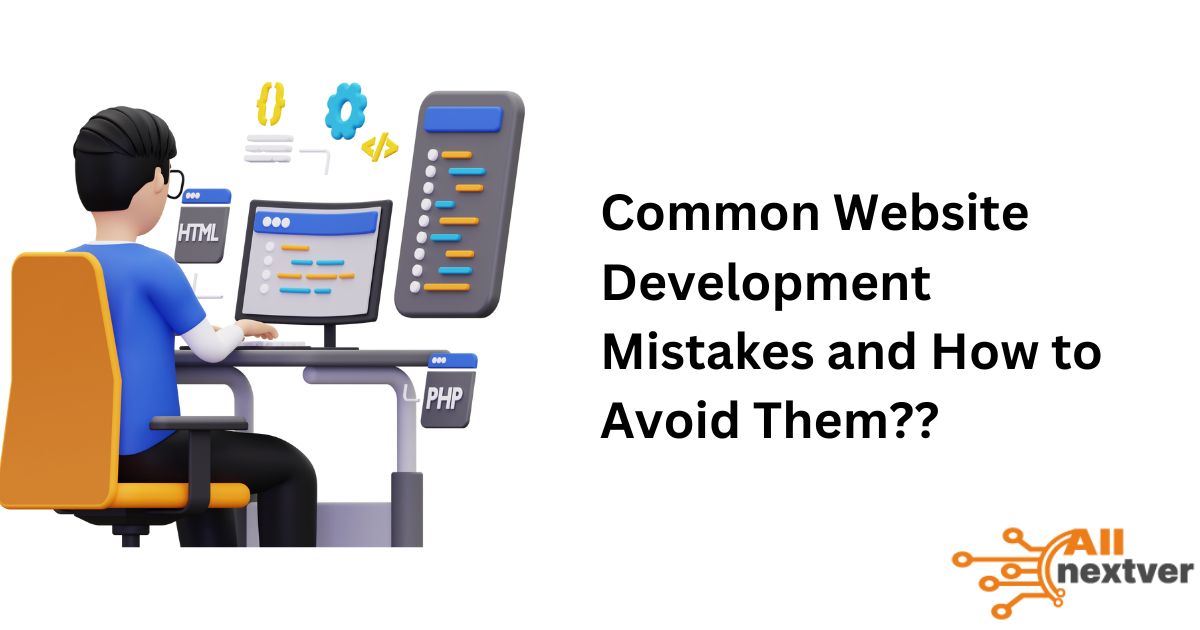Whether you are a website developer, project manager, or business owner, you should avoid these common website development pitfalls. As we all know, your website’s appearance, loading speed, and overall experience determine whether visitors stay or leave!
If your website has errors or downsides, its bounce rate will be low. This will also tank your brand’s reputation and credibility.
For that, it’s high time you reviewed this guide and discovered the most common mistakes in website development and ways to amend them.
1. Lack of Clear Objective

Lack of clear goals creates confusion. The views of your website developers and project managers should be in sync. If the team doesn’t know why a website has been made or who it will serve – they’ll fail to evaluate its outcomes.
It’s important to clarify the objectives for both project managers and developers. This way, developers can develop the right strategy and framework, while project managers can evaluate the work and determine whether it meets the objectives.
How To Avoid This Mistake
- Arrange a stakeholder meeting initially to discuss the objectives.
- Create a detailed project roadmap according to the objectives.
2. Overlooking User Experience (UX)

User experience elements are a game changer for a website. If you can nail the UX, you can impress your customers and retain them for a long time. Even big giants like Amazon invest heavily in their UX, improving their ROI.
If your website takes too long to load, it’s not optimized for mobile, and the images load slower, users will leave. About 91% of customers leave a website unsatisfied when they experience something bad.
Poor navigation also makes everything worse. If your navigation elements are unclear, your website isn’t accessible enough. If visitors cannot find what they’re looking for, they will get dissatisfied.
How To Avoid This Mistake
- Do user research and create visitor personas before building a website.
- Make your website accessible to all with clear navigation
- Test your prototype designs with the help of real users
3. Poor Mobile Optimization

A recent report shows that about 54% of users visit websites on mobile phones. Furthermore, 52% of clicks on PPC ads come from mobile devices. Therefore, it makes sense why you should focus on mobile optimization for your website.
In many cases, websites are only designed for desktops, and mobile optimization is overlooked. This only leads to a higher bounce rate.
That is to say, there’s no valid reason to leave more than half of your visitors annoyed. Since people visit websites from devices like smartphones, tablets, laptops, and TVs, your website should be optimized for different screens and devices.
How To Avoid This Mistake
- Focus on implementing the latest responsive design principles.
- Run tests on different devices and screen sizes.
4. Slow Loading Times
Website owners often fail to ensure a fast loading speed for their web pages. If a website takes too long to load, most visitors leave the site. After all, there are countless websites they can check on, and no visitors wish to waste their time on slow-loading websites.
If your website has bulky codes, large files, and lots of plug-ins, its page load speed can be affected. This is why it’s necessary to regularly monitor your website using loading speed checkers like PageSpeed Insights and Pingdom.
How To Avoid This Mistake
- Optimizing all the image and video files on your website
- Using minified codes
- Using CDN and caching to lower page load speed
5. Weak SEO Practices
Many websites are built with great aesthetics, but SEO is often overlooked. However, SEO is necessary to ensure a good user experience, and we know why UX is the key to building an effective website.
If your website content is stuffed full of keywords, overly promotional, or AI-written, it won’t cut it. Your website needs to be optimized with the SEO white hat techniques to drive more traffic and sales from Google.
How To Avoid This Mistake

- Perform keyword research to find out popular keywords your target audience searches
- Optimize your site for the latest on-page and off-page best practices
- Track your website analytics and evaluate SEO efforts regularly
6. Inadequate Security Measures
Owners should emphasize on website security measures during website development. Strong security features protect your site even if the security isn’t directly related to the development.
Collaborate with the developer team and ensure strong security measures are in place, such as passwords, authentication, backup strategies, and so on.
How To Avoid This Mistake
- Add SSL certificates to the website
- Ask your developers to monitor plugins and applications regularly
- Turn on two-factor authentication
- Use a strong password that only selected individuals can access
7. Poor Content Management

Even a nice-looking, UX-friendly website can cause lots of hassle because of a poor content management system. A website needs fresh and updated information, so you should have a system that lets you update, edit, and publish content.
How To Avoid This Mistake
- Select a user-friendly Content Management System (CMS) for your website
- Hire experts or train your staff to navigate CMS properly
- Prepare content strategy and editorial calendar to deploy fresh content regularly
8. Overlooking Analytics and Tracking
SEO is incomplete without an analytics system. You need an analytics tool to discover your site’s problems, the improvements it needs, and the effects of your SEO strategy.
Website analytics and tracking tools collect data from your website to show insights on web traffic, audience behavior, popular pages, etc. But before that, a web analytics tool must be integrated with your website.
How To Avoid This Mistake
- Determine important KPIs to track and monitor
- Integrate Google Analytics or Tools like Semrush
- Use collected insights to make informed decisions.
9. Lack of Scalability
Another big misstep is not preparing for the future and your growth stages. What if your business needs a larger website with more server space and added functionality? Therefore, businesses should aim to build websites that can be scaled as needed.
How To Avoid This Mistake
- Select technologies and frameworks that can be scaled later.
- Aim for flexible designs that can be modified as needed.
- Regularly monitor and update elements for added load.
10. Inconsistent Branding

You’ll see many websites with inconsistent branding. That means using different colors, text fonts, and language styles on multiple pages.
A website should have a strong brand identity, including colors, fonts, and a fixed tone and voice for all content that speaks to a specific target audience.
How To Avoid This Mistake
- Create and follow a brand guide for fonts, colors, tone, and voice.
- Be consistent with the brand guidelines across all the web pages.
Conclusion
Focusing on avoiding these mistakes before you begin a web development project can help you avoid them.
Ensure your websites are user-friendly, accessible, and up-to-date with the latest SEO and UX practices. Moreover, monitor your websites regularly and update them to keep them in top condition.
Are you looking to build a new website or redo an existing one? Let our web developers do the work for you. Contact us today!



